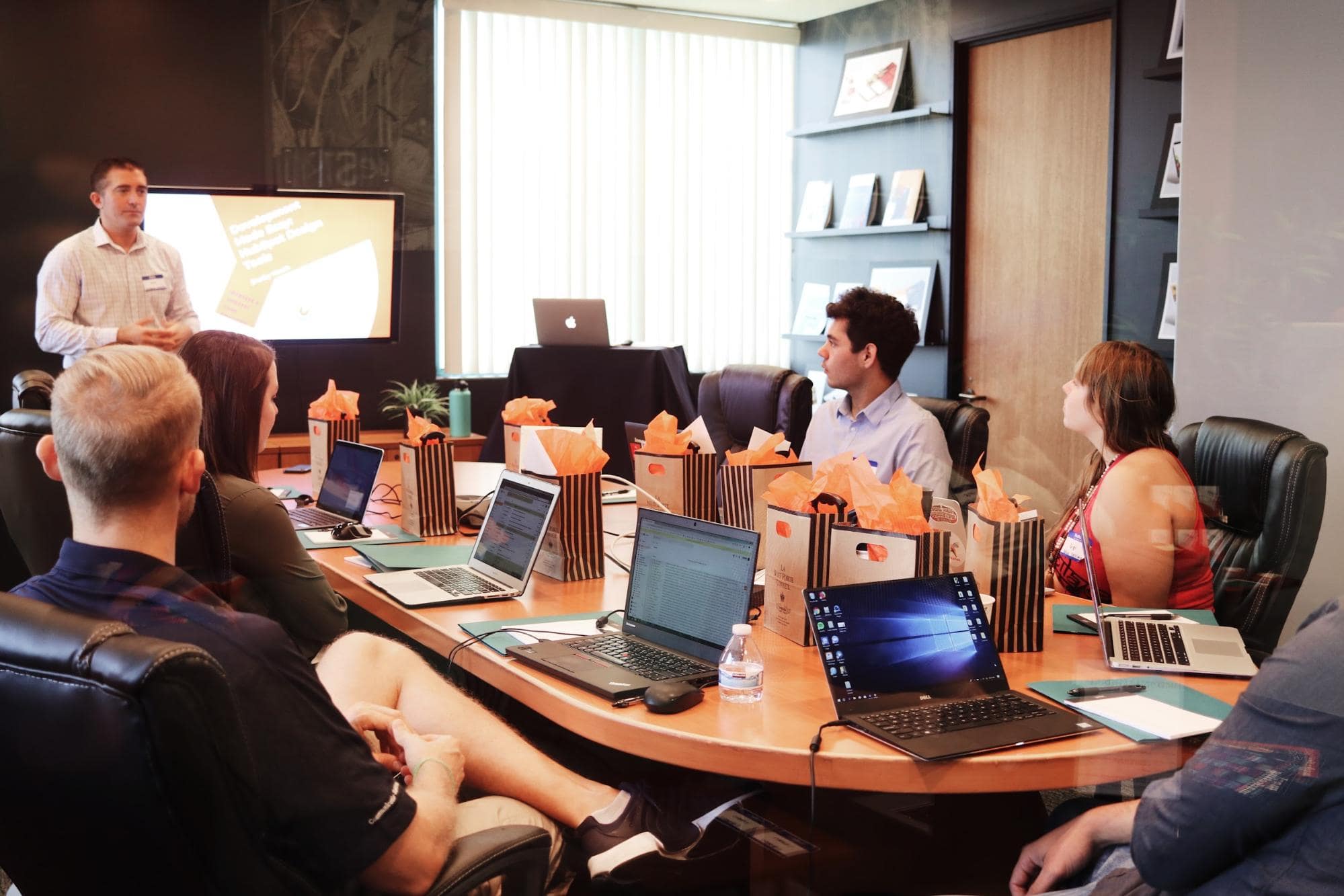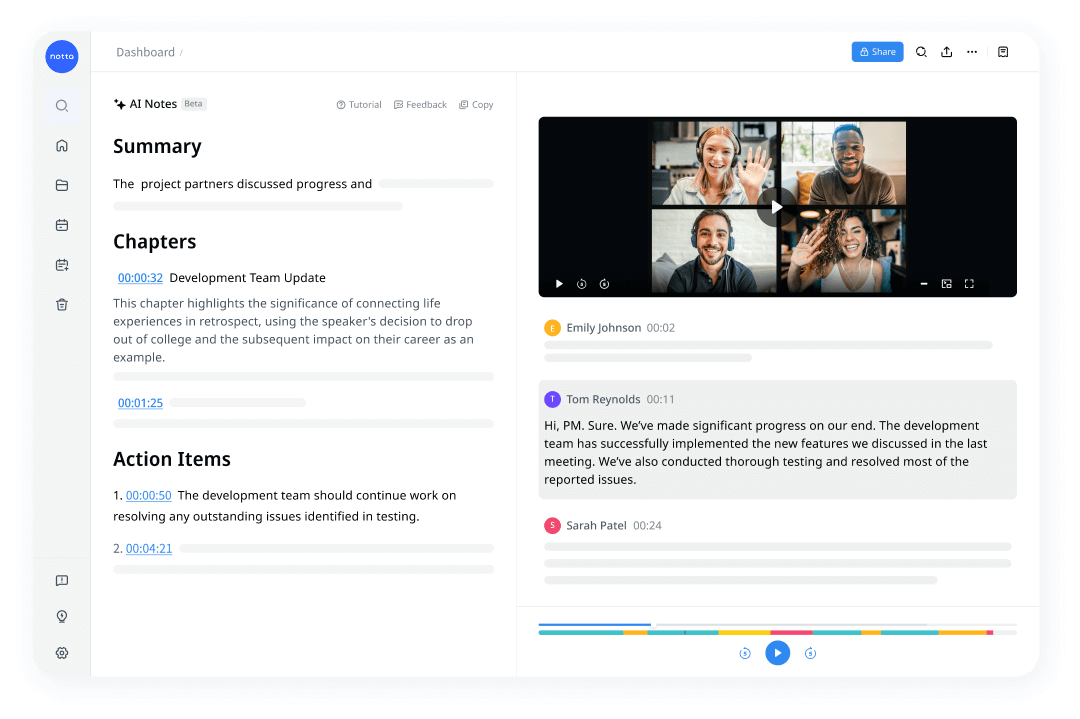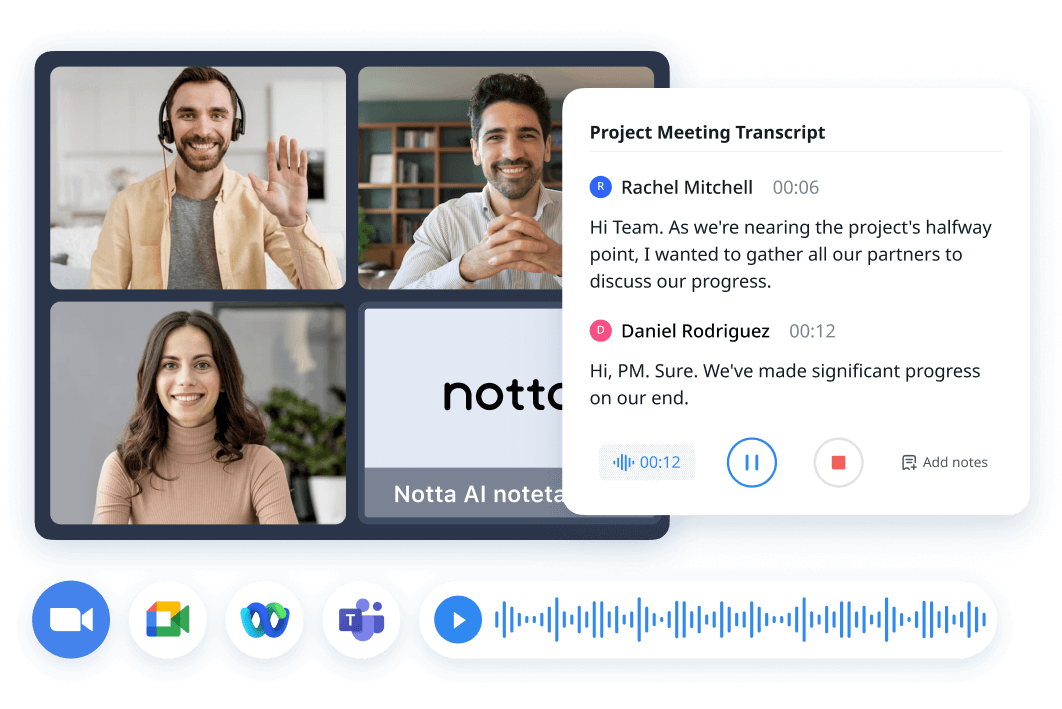
How to Plan & Run a Client Meeting Like a Pro
Unlock the power of AI — Notta's meeting assistant records, transcribes and summarizes meeting minutes with one click.
Seven seconds – that’s how long it takes for a client to know if they want to work with you, says a study by Observer.
An unsuccessful client meeting has the potential to tank major deals. Ask Nike. They lost a chance to collaborate with Stephen Curry because they got his name wrong in their initial pitch.
This tells us:
Even for the biggest of brands – client meetings are tricky waters.
You need to perfect every detail of a client meeting — because they expect you to.
Knowing how to run a client meeting is crucial for the success of your business. They can help you close more sales, build stronger relationships, and even get referrals. This article will help you get started.
Let’s go!
5 most common types of client meetings
To prepare for a client meeting, you have to understand what stage you are in and the purpose of the meeting; therefore, you can better handle it.
For example, introduction meetings are slower-paced, aiming to get an understanding of each other. In contrast, consultation meetings are faster-paced as the aim is to provide as much value as possible to nail a deal with the client.
Introductory meetings
These are the first-time client meetings you have with a new client; they're all about getting to know each other. You will introduce your company and services and answer any questions from the client. By the end of the meeting, you should have a good sense of whether you're a good fit for each other.
Introductory meetings are important because they establish a connection between the two sides and help you and the client identify a potential business opportunity.
Consultations
Following the introductory meeting is the consultation client meeting, where you’re on a call with someone already interested in your services.
These meetings involve some back-and-forth so both parties can ask and answer questions. The goal of a consultation client meeting is usually to get a better sense of the client’s needs. You'll want to show the clients that you are qualified and can deliver fruitful results.
At the same time, the client will examine your company credentials and decide if you're somebody who can help them achieve their goals.
Sales presentation
A sales presentation is a formal speech, with or without a slide, to showcase a product or service to potential clients.
Here, you will deliver a proper sales pitch for your services and highlight key benefits to the client. The goal of a sales presentation is to address any concerns the client may have and close a deal.
Proposal meetings
A proposal meeting is a meeting between a prospective client and a vendor, usually to discuss a potential project. The purpose is to:
Research the project
Prepare a detailed outline of the next steps in the event you reach a cooperation
Gather feedback from the client
In many cases, the client already has a good idea of what they want from the meeting. It is up to the company to ensure that they can address all the client's concerns.
Client check-ins
In this stage, you’ve started working with the client. The deal has been finalized– but this is not the end. To maintain smooth cooperation, you should check in periodically to ensure the project is on track.
You can also use these meetings to see if the client faces any challenges and help think of a solution。
5 steps to run an effective client meeting
A client meeting is a key opportunity to build relationships and create a lasting impression. Here are five client meeting tips to help achieve this goal:
1. Research your client beforehand
After sending a meeting invitation email to your client and deciding on the time, you need to do thorough research about your client to increase the number of talking points you have, making it much easier to connect with the client. It will also give you insight into their business style and interests that you can base your proposal on.
Doing research involves more than just a Google search — although that's a good start. Here are a few easy ways to research your client.
When we say “client”, we often refer to a company or its representative. Try finding out who will be present in the meeting and look them up on LinkedIn. See if you have any mutual connections.
Find out what their company's priorities are for the upcoming year.
Review any existing materials, such as a website or marketing collateral.
2. Prepare for your meeting
Before meeting with a client, it's important to take some time to prepare. First, understand the purpose of the meeting - what topics will you plan to discuss?
Here is a list of questions to ask yourself when preparing for a client meeting:
What are you hoping to accomplish during this meeting?
What does the client need from you to be successful?
What are their concerns and expectations?
Once you’ve decided on the topics for the meeting, you need to figure out how you can help with your service or products. For example, if the client needs to improve meeting efficiency, you must list your advantages and why you are better than others.
Find some data that supports your claims. This could be market research reports, case studies, or even testimonials from past clients.
3. Create and stick to the agenda
An agenda acts as a guide to keep your meeting on track. To create an effective agenda, start by listing all the topics you want to discuss, arranged by importance or urgency. Here’s what you should include in a meeting agenda:
Meeting date and participants
The main topics of discussion and time allotment
Goals for the project
Documents that support your project plan
Client questions
Action items
Before the meeting, review the agenda with the client to make sure everyone is on the same page. If anything comes up that isn't on the agenda, make a note of it and add it to the list.
To make creating a client meeting agenda easier, we’ve created a free template that does just that for you.
It is also essential to stick to the agenda during the client meeting to ensure you don’t miss out on necessary subjects.
4. Wrap up the meeting
At the end of the meeting, it is important to recap what you discussed to ensure everyone is on the same page moving forward. Follow this checklist when it is time to wrap up a meeting.
Thank the client for their time and input.
Provide a brief overview of the main topics that you covered.
Confirm any next steps or deadlines.
Make sure that the client has the relevant information they need.
Let them know that you are looking forward to working together.
This small step will immediately set you apart from the crowd – as most people fumble at the end of meetings and drop the professionalism ball.

5. Meeting follow up
After any client meeting, it's essential to follow up with a thank-you note, which functions as an opportunity to recap the meeting and reiterate your commitment to the project.
You can take this opportunity to highlight critical decisions, talk about immediate steps, and, if necessary, ask to set up the next meeting (with prospective dates)
Be sure to keep the follow-up short and avoid mentioning any details that could be controversial or open to interpretation.
Notta offers the most integrated AI meeting notes, summaries, and action items so nothing gets missed.
Tips for a successful client meeting
When meeting with a client, there are a few things to keep in mind to make sure the meeting is successful.
Take notes and summarize smartly.
As the old saying goes “The palest ink is better than the best memory”, taking meeting notes is crucial and helps capture important information.
If your client agrees to it, using an AI notataker like Notta to record and transcribe your meeting conversations in real-time for you, whether online or in-person, so you remain fully engaged in the conversation without worrying about losing any details. You can also review them whenever you want and share the meeting notes with colleagues.
What's better, Notta leverages AI to generate a comprehensive summary from the transcript, making your follow-up much easier.

Be respectful of the client’s time.
Do not go over the allotted time for the meeting. This can be frustrating for the client, especially if they have other matters scheduled. If you need more time, try to schedule another meeting. If that's not possible, try to be as concise as possible.
Be aware of body language and nonverbal cues.
It is important to sit up straight and make eye contact with the client to appear interested and engaged in the conversation. Do avoid fidgeting, as clients may see this as a sign of impatience or nervousness.
Listen actively.
This means not only hearing what the client is saying but also trying to understand their needs and concerns. Active listening leads to success in many fields, e.g., human resources.
Never miss the mark with your client meetings
How you act and what you say during a client meeting can secure a client or sour a relationship forever.
Many businesses fail to emphasize this aspect of their operation, leading to lost opportunities and unhappy clients. Remember to:
Research the client
Have supporting materials for your claims
Create and stick to the meeting agenda
Wrap up the meeting on a positive note
Follow up to show your commitment